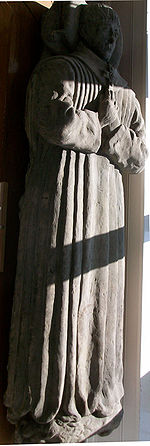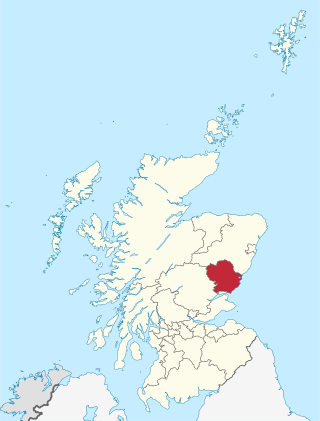
Angus is one of the 32 local government council areas of Scotland, a registration county and a lieutenancy area. The council area borders Aberdeenshire, Dundee City and Perth and Kinross. Main industries include agriculture and fishing. Global pharmaceuticals company GSK has a significant presence in Montrose in the north of the county.
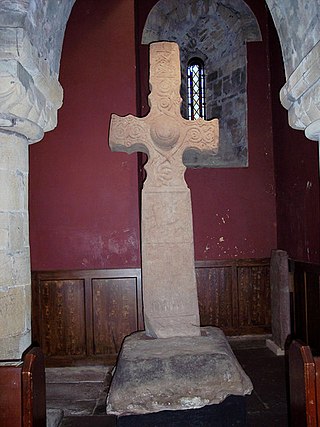
Causantín or Constantín mac Fergusa was king of the Picts, in modern Scotland, from 789 until 820. He was until the Victorian era sometimes counted as Constantine I of Scotland; the title is now generally given to Causantín mac Cináeda. He is credited with having founded the church at Dunkeld which later received relics of St Columba from Iona.

Dyce is a suburb of Aberdeen, Scotland, situated on the River Don about 6 mi (10 km) northwest of the city centre. It is best known as the location of Aberdeen Airport.
Glamis is a small village in Angus, Scotland, located 4 miles (6.4 km) south of Kirriemuir and 5 miles (8.0 km) southwest of Forfar. It is the location of Glamis Castle, the childhood home of Queen Elizabeth the Queen Mother.
Saint Drostan, also Drustan, was the founder and abbot of the monastery of Old Deer in Aberdeenshire. His relics were translated to the church at New Aberdour and his holy well lies nearby.
Saint Regulus or Saint Rule was a legendary 4th century monk or bishop of Patras, Greece who in AD 345 is said to have fled to Scotland with the bones of Saint Andrew, and deposited them at St Andrews. His feast day in the Aberdeen Breviary is 17 October.
Máel Ruba is an Irish saint of the Christian Church who was active in Scotland. Originally from Bangor, County Down, Ireland, he was a monk and founded the monastic community of Applecross in Ross, one of the best attested early Christian monasteries in what is now Scotland. Forms of his name include Máelrubai, Maol Rubha (MoRubha/MaRuibhe), or Malruibhe, and it is sometimes Latinised as Rufus,
Saint Curetán was a Scoto-Pictish bishop and saint,. He is listed as one of the witnesses in the Cáin Adomnáin, where he is called "Curetan epscop". In the Martyrology of Tallaght he is called "of Ross Mand Bairend", and in the Martyrology of O'Gorman he is styled "bishop and abbot of Ross maic Bairend". His bishopric is usually held to have been Ross, the seat of which was at the settlement in the Black Isle called Ros-Maircnidh or Rosemarkie, named after the adjacent promontory
Cellach I is traditionally said to have been the first Bishop of the Scots, the bishopric later based at St. Andrews. He is mentioned in the historical writings of Walter Bower and Andrew of Wyntoun as a bishop of St. Andrews, but no pre-15th century sources say anything more than merely "Bishop". Wyntoun and Bower make him bishop as early as the reign of King Giric of Scotland (877x878-885x889). He was still bishop in the reign of King Causantín II of Scotland in 906 when, "in his sixth year King Causantín and Bishop Cellach met at the hill of belief near the royal city of Scone and pledged themselves that the laws and disciplines of the faith, and the laws of churches and gospels, should be kept in conformity with the customs of the Gaels". One interpretation of this passage is the demise of the "Pictish church" to the reforming Gaels, however it is certain that by the 15th century the bishop-list of the principal Scottish see was looking back at Cellach as its first bishop. His death date is unknown, but unsurprisingly he was certainly dead by the 960s when his successor Fothad I died as bishop.

Saint Moluag was a Scottish missionary, and a contemporary of Saint Columba, who evangelized the Picts of Scotland in the sixth century. Saint Moluag was the patron saint of Argyll as evidenced by a charter in 1544, from the Earl of Argyll, which states "in honour of God Omnipotent, the blessed Virgin, and Saint Moloc, our patron". The House of Lorne became the kings of Dalriada and eventually united with the Picts to become the kings of Scots.

The Aberdeen Breviary is a 16th-century Scottish Catholic breviary. It was the first full-length book to be printed in Edinburgh, and in Scotland.

The Eassie Stone is a Class II Pictish stone of about the mid 8th century AD in the village of Eassie, Angus, Scotland. The stone was found in Eassie burn in the late 18th century and now resides in a purpose-built perspex building in the ruined Eassie church.

Eassie is a village located along the A94 road in Angus, Scotland. The church in Eassie is dedicated to Saint Fergus, a monk who worked at nearby Glamis. Eassie is noted for the presence of the Eassie Stone, a carved Pictish stone, which resides in the ruins of Eassie Old Church.
Talarican (Tarkin) was a Scottish Bishop of Sodor of the eighth century.
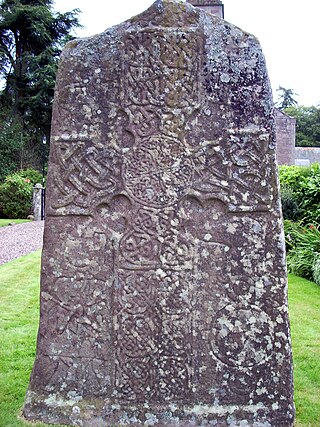
The Glamis Manse Stone, also known as Glamis 2, is a Class II Pictish stone at the village of Glamis, Angus, Scotland. Dating from the 9th century, it is located outside the Manse, close to the parish church. It is inscribed on one side with a Celtic cross and on the other with a variety of Pictish symbols. It is a scheduled monument.

Kinneddar is a small settlement on the outskirts of Lossiemouth in Moray, Scotland, near the main entrance to RAF Lossiemouth. Long predating the modern town of Lossiemouth, Kinneddar was a major monastic centre for the Pictish kingdom of Fortriu from the 6th or 7th centuries, and the source of the important collection of Pictish stones called the Drainie Carved Stones. The Kirk of Kinneddar was the cathedral of the Diocese of Moray between 1187 and 1208, and remained an important centre of diocesan administration and residence of the Bishop of Moray through the 13th and 14th centuries.
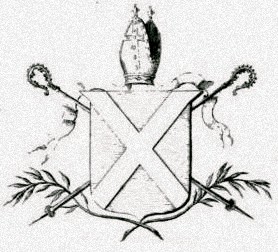
The Archdiocese of St Andrews was a territorial episcopal jurisdiction of the Catholic Church in early modern and medieval Scotland. It was the largest, most populous and wealthiest diocese of the medieval Scottish Catholic church, with territory in eastern Scotland stretching from Berwickshire and the Anglo-Scottish border to Aberdeenshire.

The Woodwrae Stone is a Class II Pictish Stone that was found in 1819 when the foundations of the old castle at Woodwrae, Angus, Scotland were cleared. It had been reused as a floor slab in the kitchen of the castle. Following its removal from the castle, it was donated to the collection of Sir Walter Scott at Abbotsford House. It is now on display at the Museum of Scotland in Edinburgh.
Ethernan was a 7th century Scottish martyr and saint.
Saint Vimin was a Scottish abbot and bishop. He is said to have founded Holywood Abbey in Fife, Scotland. However, there are no reliable sources for his life. His feast day is 21 January.
